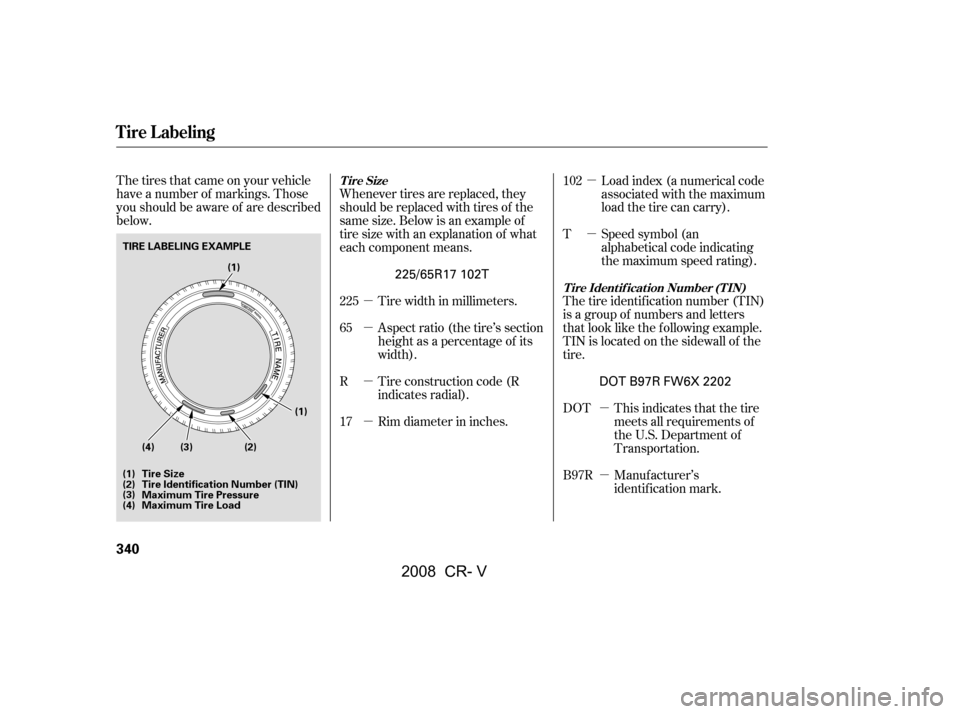Page 314 of 373

Fill the f uel tank.Block the rear wheels.
If the vehicle is to be stored f or a
longer period, it should be
supported on jackstands so the
tires are of f the ground.
Cover the vehicle with a
‘‘breathable’’ cover, one made
f rom a porous material such as
cotton. Non-porous materials, such
as plastic sheeting, trap moisture,
which can damage the paint.
If you need to park your vehicle f or
an extended period (more than 1
month), there are several things you
should do to prepare it f or storage.
Proper preparation helps prevent
deterioration and makes it easier to
get your vehicle back on the road. If
possible, store your vehicle indoors. Leave one window open slightly (if
the vehicle is being stored
indoors).
Disconnect the battery.
Support the f ront and rear wiper
blade arms with a f olded towel or
ragsotheydonottouchthe
windshield.
To minimize sticking, apply a
silicone spray lubricant to all door
and tailgate seals. Also, apply a
vehiclebodywaxtothepainted
surfaces that mate with the door
and tailgate seals.If possible, periodically run the
engine until it reaches f ull
operating temperature (the
cooling f ans cycle on and of f
twice). Pref erably, do this once a
month.
Wash and dry the exterior
completely.
Cleantheinterior.Makesurethe
carpeting, floor mats, etc., are
completely dry.
Leave the parking brake off. Put
the transmission in Park.
Vehicle Storage
310
�\f���—�\f���—�����y�
����
����
���y���
�(�,�����
�\f�y�\f���
���y
2008 CR- V
Page 316 of 373

Replace the tire when you can see
the tread wear indicator bars. The
replacement should be the same size
and design tire, mounted on the
same wheel. The spare tire is not
designed to be mounted on a regular
wheel, and the spare wheel is not
designed f or mounting a regular tire.
Do not mount snow chains on the
compact spare tire.
Use the compact spare tire as a
temporary replacement only. Get
your regular tire repaired or replaced,
and put it back on your vehicle as
soon as you can.
Check the inf lation pressure of the
compact spare tire every time you
check the other tires. It should be
inf lated to:
Follow these precautions:
Never exceed 50 mph (80 km/h).
This tire gives a harsher ride and
less traction on some road
surf aces. Use greater caution
while driving. Do not use your compact spare
tire on another vehicle unless it is
thesamemakeandmodel.
The low tire pressure indicator
comes on and stays on af ter you
replace the flat tire with the
compact spare tire. Af ter several
miles (kilometers) driving with the
compact spare tire, the TPMS
indicator comes on and the low
tire pressure indicator goes of f .
Compact Spare Tire
312
INDICATOR LOCATION MARK
TREAD WEAR INDICATOR BAR
60 psi (420 kPa , 4.2 kgf/cm)
�\f���—�\f���—�����y�
����
��������y���
�(�,�����
�\f�y�\f���
���y
2008 CR- V
Page 336 of 373
The operator will load
your vehicle on the back of a truck.
Any other method of towing will
damage the drive system. When you
contact the towing agency, inf orm
them a f lat-bed is required.
If your vehicle needs to be towed,
call a prof essional towing service or
organization. Never tow your vehicle
with just a rope or chain. It is very
dangerous. Refer to
on page
for non-emergency towing
inf ormation. 266
On 4WD models
The only way you can saf ely tow
your vehicle is with f lat-bed
equipment. Towing Your Vehicle
Behind a Motorhome
Emergency Towing
332
Towing with only two tires on the
ground will damage parts of the 4WD
system. It should be transported on a
f lat-bed truck or trailer.
�\f���—�\f���—�����y�
����
��������y���
�(�,�����
�\f�y�\f�������y
2008 CR- V
Page 337 of 373

�µ
Thediagramsinthissectiongive
you the dimensions and capacities of
your vehicle and the locations of the
identif ication numbers. It also
includes inf ormation you should
know about your vehicle’s tires and
emissions control systems.
................
Identif ication Numbers .334
................................
Specif ications .336
DOT Tire Quality Grading
......................
(U.S. Vehicles) .338
Unif orm Tire Quality ..................................
Grading .338
.................................
Treadwear .338
......................................
Traction .338
.............................
Temperature .339
.................................
Tire Labeling .340
Tire Pressure Monitoring System
(TPMS) Required Federal ............................
Explanation .342 .......................
Emissions Controls .344
.....................
The Clean Air Act .344
Crankcase Emissions Control
....................................
System .344
Evaporative Emissions Control ....................................
System .344
Onboard Ref ueling Vapor ................................
Recovery .344
...
Exhaust Emissions Controls .345
....................
PGM-FI System .345
Ignition Timing Control
................................
System .345
Exhaust Gas Recirculation ...................
(EGR) System .345
Three Way Catalytic ...........................
Converter .345
....................
Replacement Parts .345
..
Three Way Catalytic Converter .346
........................
Emissions Testing .347
T echnical Inf ormation
Technical Inf ormation
333
�\f���—�\f���—�����y�
����
����\f���y���
�(�,�����
�\f�y�\f�������y
2008 CR- V
Page 341 of 373

�µ
�µ�µ
�µ
�µ
�µ
�µ
�µ
�µ
�µ
�µ
�µ
�µ
�µ
�µ
�µ
�µ
Specif ications
Technical Inf ormation
337
Fuses
Alignment
Tires
Battery
Lights
Air Conditioning
Seating Capacities Interior
Under-hood
Toe-in
Camber
Caster0.0in(0mm)
0.08 in (2.0 mm) 0°
1°00’
1°45’
225/65R17 102T
Size
Pressure
30 psi (210 kPa , 2.1 kgf/cm
)
30 psi (210 kPa , 2.1 kgf/cm)
T155/90D17 101M
60 psi (420 kPa , 4.2 kgf/cm
)
Capacity 12 V
12 V47 AH/20 HR
36 AH/5 HR
12 V
12 V
12 V
12 V
12 V
12 V
12 V
12 V
12 V
12 V
12 V
12 V
21 W
5W
8W
8W
8W
5W
21 W
21/5 W
21 W
3CP
21 W
50/55 W
Headlights
Front turn signal lights
Parking lights/side marker
lights
Rear turn signal lights
Stop/Taillights
Back-up lights
License plate light
Ceiling light
Spotlights
Cargo area light
Rear side marker lights
High-mount brake light
Refrigerant type
Charge quantity
Lubricant type SP-10 15.5 17.3 oz (440 490 g)HFC-134a (R-134a) 5
2
3
See page330or the fuse label
attached under the steering
column.
See page331or the fuse box
cover.
Total
Front
Rear
Front
Rear
Front
Rear
Front
High/Low (HB2)
Front/Rear
Spare
Front
Rear
Spare
(Amber)
(Amber)
�\f���—�\f���—�����y�
����
�
����\f�y���
�(�,�����
�\f�y�\f�������y
2008 CR- V
Page 342 of 373

The tires on your vehicle meet all
U.S. Federal Saf ety Requirements.
All tires are also graded f or
treadwear, traction, and temperature
perf ormance according to
Department of Transportation
(DOT) standards. The f ollowing
explains these gradings.
Quality grades can be f ound where
applicable on the tire sidewall
between tread shoulder and
maximum section width. For
example:The treadwear grade is a compara-
tive rating based on the wear rate of
the tire when tested under controlled
conditions on a specif ied government
test course. For example, a tire
graded 150 would wear one and one-
half (1 1/2) times as well on the
government course as a tire graded
100. The relative perf ormance of
tires depends upon the actual condi-
tions of their use, however, and may
depart signif icantly f rom the norm
due to variations in driving habits,
service practices and dif f erences in
road characteristics and climate.The traction grades, f rom highest to
lowest, are AA, A, B, and C. Those
grades represent the tire’s ability to
stop on wet pavement as measured
under controlled conditions on
specif ied government test surf aces
of asphalt and concrete. A tire
marked C may have poor traction
perf ormance.
Warning: The traction grade
assignedtothistireisbasedon
straight-ahead braking traction tests,
and does not include acceleration,
cornering, hydroplaning, or peak
traction characteristics.
All passenger car tires must conf orm
to Federal Saf ety Requirements in
addition to these grades. T readwear 200
Traction AA
Temperature A
Unif orm T ire Quality Grading T readwear T raction
DOT Tire Quality Grading (U.S. Vehicles)
338
�\f���—�\f���—�����y�
������\f��\f�
�y���
�(�,�����
�\f�y�\f�������y
2008 CR- V
Page 343 of 373

Warning: The temperature grade f or
this tire is established f or a tire that
is properly inf lated and not
overloaded. Excessive speed,
underinf lation, or excessive loading,
either separately or in combination,
can cause heat buildup and possible
tire f ailure.
The temperature grades are A (the
highest), B, and C, representing the
tire’s resistance to the generation of
heat and its ability to dissipate heat
when tested under controlled
conditions on a specif ied indoor
laboratory test wheel. Sustained high
temperature can cause the material
of the tire to degenerate and reduce
tire life, and excessive temperature
can lead to sudden tire f ailure. The
grade C corresponds to a level of
perf ormance which all passenger car
tires must meet under the Federal
Motor Vehicle Saf ety Standard No.
109. Grades B and A represent
higher levels of perf ormance on the
laboratory test wheel than the
minimum required by law.
Temperature
DOT Tire Quality Grading (U.S. Vehicles)
Technical Inf ormation
339
�\f���—�\f���—�����y�
������\f��\f���y���
�(�,�����
�\f�y�\f�������y
2008 CR- V
Page 344 of 373

�µ
�µ
�µ
�µ
�µ
�µ
�µ
�µ
The tires that came on your vehicle
have a number of markings. Those
you should be aware of are described
below.
Load index (a numerical code
associated with the maximum
load the tire can carry).
Speed symbol (an
alphabetical code indicating
the maximum speed rating).
The tire identif ication number (TIN)
is a group of numbers and letters
that look like the f ollowing example.
TIN is located on the sidewall of the
tire.
This indicates that the tire
meets all requirements of
the U.S. Department of
Transportation.
Whenever tires are replaced, they
should be replaced with tires of the
same size. Below is an example of
tire size with an explanation of what
each component means.
Tire width in millimeters.
Aspect ratio (the tire’s section
height as a percentage of its
width).
Tire construction code (R
indicates radial).
Rim diameter in inches. Manuf acturer’s
identification mark.
R
DOT
B97R
65
T
102
225
17
Tire Labeling
T ire Ident if icat ion Number (T IN)
Tire Size
340
(1)
(1)
(3) (2)
TIRE LABELING EXAMPLE
(1)
(2)
(3)
(4)
Tire Size
Tire Identification Number (TIN)
Maximum Tire Pressure
Maximum Tire Load
(4)
DOT B97R FW6X 2202
225/65R17 102T
�\f���—�\f���—�����y�
������\f��
���y���
�(�,�����
�\f�y�\f�������y
2008 CR- V